References
Woven Signals, Anne-Marie Lavigne
The form is the outer expression of the inner content. One should not make a deity of form. And one should fight for the form only insofar as it can serve as a means of expression of the inner resonance. Ultimately one should not seek salvation in one form.
– Wassily Kandinsky, “On The Problem of Form”, 1912
Guest Speakers
Sarah Rothberg, Narrative in Immersive VR
Narrative: a way of organizing occurrences into a coherent sequence
“Narrative” means any technique that produces the visceral desire in a reader to want to know what happened next.
– Bob Baker, Los Angeles Times
Virtual Reality: a “kind-of” reality immersion, presence, agency
Things to Consider in Immersive Digital Experiences:
- Providing causality in narratives
- The user will be in a 360 environment
- VR breaks the teller-listener paradigm
- The user still exists in physical reality
- Where, how, and by whom will this be seen?




